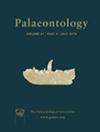中生代始祖类的相对颅骨尺寸演化:红系始祖类的潜在驱动因素和形态独特性
IF 2.3
2区 地球科学
Q1 PALEONTOLOGY
引用次数: 3
摘要
在始祖龙中,头骨尺寸相对于身体尺寸的大规模进化模式,以及这些模式背后可能的驱动因素,我们知之甚少。例如,早三叠纪和中三叠纪的一组非始祖恐龙和兽脚亚目恐龙的大头骨被认为是对高食肉性的趋同适应。然而,很少有研究明确地测试了类红目恐龙和兽脚亚目恐龙的头骨是否确实与它们的体型不成比例地大,以及这种趋势是否由过度食肉驱动。在此,我们研究了古生代和中生代始祖的相对颅骨尺寸进化,利用强大的系统发育框架研究了颅骨和体型之间的比例关系,并评估了潜在驱动因素的影响,如分类、饮食、运动模式和居住的生物群落。我们的研究结果表明,始祖类的相对颅骨大小在很大程度上取决于系统发育,而其他驱动因素的影响程度要弱得多。我们发现负异速缩放头骨大小相对于身体大小,当所有研究的始祖形态进行分析。在特定群体中,非始祖龙类的颅骨尺寸呈正异速分布,而有趣的是,兽脚亚目的颅骨尺寸呈等距分布。对祖先颅骨-股骨大小比例的重建显示,红足科的基部有一个不成比例的大头骨,而兽脚亚目、肉龙目和暴龙目的基部有不成比例的大头骨。因此,蜥脚类恐龙和兽脚亚目恐龙的相对头骨大小是不同的,这表明不成比例的大头骨并不是原蜥脚类动物过度食肉的先决条件,而且蜥脚类恐龙在中生代陆生食肉动物中表现出独特的头骨形状。本文章由计算机程序翻译,如有差异,请以英文原文为准。
Relative skull size evolution in Mesozoic archosauromorphs: potential drivers and morphological uniqueness of erythrosuchid archosauriforms
Little is known about the large‐scale evolutionary patterns of skull size relative to body size, and the possible drivers behind these patterns, in Archosauromorpha. For example, the large skulls of erythrosuchids, a group of non‐archosaurian archosauromorphs from the Early and Middle Triassic, and of theropod dinosaurs are regarded as convergent adaptations for hypercarnivory. However, few investigations have explicitly tested whether erythrosuchid and theropod skulls are indeed disproportionately large for their body size, and whether this trend is driven by hypercarnivory. Here, we investigate archosauromorph relative skull size evolution, examining the scaling relationships between skull and body size of Palaeozoic and Mesozoic archosauromorphs using a robust phylogenetic framework and assessing the influence of potential drivers, such as taxonomy, diet, locomotory mode and inhabited biotope. Our results show that archosauromorph relative skull sizes are largely determined by phylogeny and that the other drivers have much weaker levels of influence. We find negative allometric scaling of skull size with respect to body size when all studied archosauromorphs are analysed. Within specific groups, skull size scales with positive allometry in non‐archosaurian archosauromorphs and, interestingly, scales isometrically in theropods. Ancestral reconstructions of skull–femur size ratio reveal a disproportionately large skull at the base of Erythrosuchidae and proportionately sized skulls at the bases of Theropoda, Carnosauria and Tyrannosauroidea. Relative skull sizes of erythrosuchids and theropods are therefore distinct from each other, indicating that disproportionately large skulls are not a prerequisite for hypercarnivory in archosauromorphs, and that erythrosuchids exhibit a bauplan unique among terrestrial Mesozoic carnivores.
求助全文
通过发布文献求助,成功后即可免费获取论文全文。
去求助
来源期刊

Palaeontology
地学-古生物学
CiteScore
5.60
自引率
3.80%
发文量
43
审稿时长
6 months
期刊介绍:
Palaeontology publishes a wide variety of papers on palaeontological topics covering:
palaeozoology
palaeobotany
systematic studies
palaeoecology
micropalaeontology
palaeobiogeography
functional morphology
stratigraphy
taxonomy
taphonomy
palaeoenvironmental reconstruction
palaeoclimate analysis and biomineralization studies.
 求助内容:
求助内容: 应助结果提醒方式:
应助结果提醒方式:


